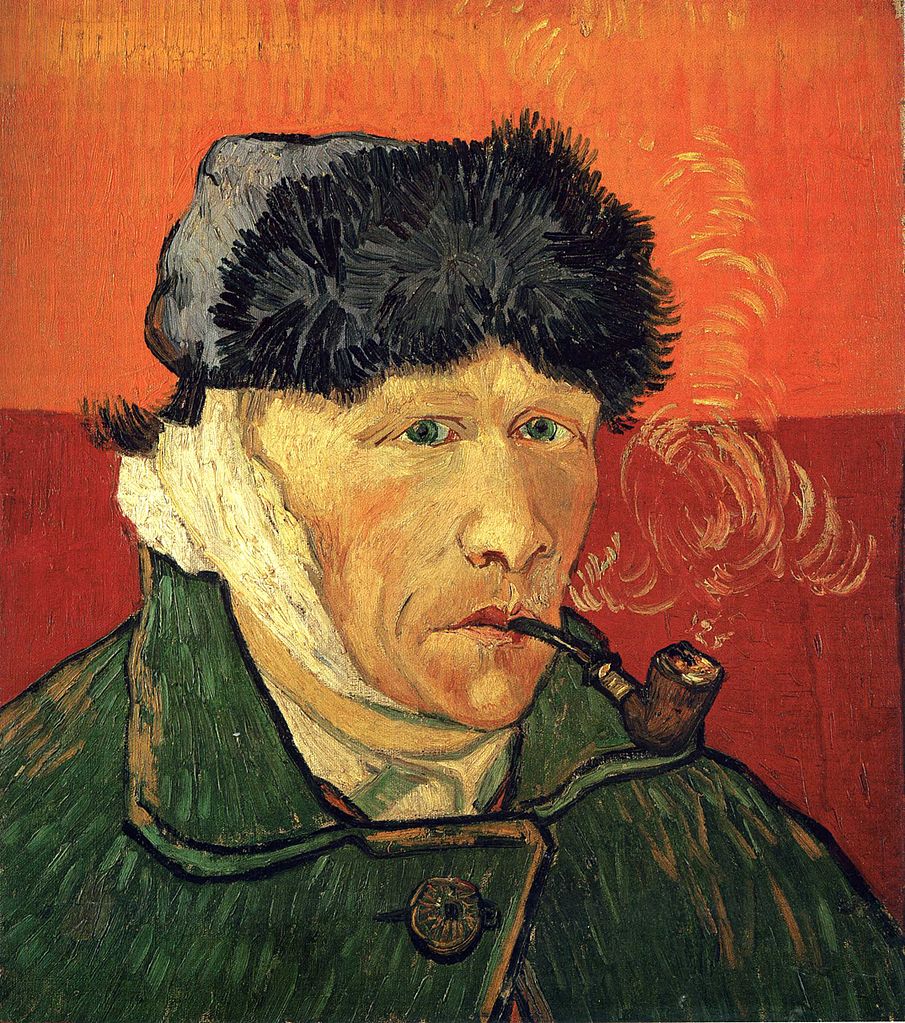Vincent Van Gogh was an admired artist, who was also a troubled and “tortured genius.” His artwork, Starry Night, Bedroom in Arles, and many others have earned him fame and recognition as one of the greatest artists of his time. But what many remember most about this artist is the story of his severed ear. Although his art is exemplary, his struggle with mental health and self-harm is admirable. His struggle was overlooked due to his incredible talent. He was successful as an art dealer, but as an artist, he had to prove himself with the headquarters of international art dealers, Gopil & Cie. During his lifetime, Van Gogh was the poster boy for the image of starving artist. His artwork was not recognized until much later in his career, which could have been a leading cause of his major depression and anxiety.1
Van Gogh, born in the Netherlands, decided to start his career in Paris in the 1880s, where many of the age’s great artists also resided. He believed he could get recognition for his pieces through his younger brother, Theo, who made his living as an art dealer. His brother introduced him to many artists, including Georges Seaurat, Camille Pisatto, and Paul Gauguin. Upon meeting these successful artists, Van Gogh was greatly inspired by their work and began creating his own artistic style, beginning in 1883. Later the same year, Van Gogh rented a small house in Arles, in the south of France. Paul Gauguin and Van Gogh became close friends and later roommates. They consistently bounced ideas off of each other and created a strong friendship.2

Like many friendships, theirs was rocky, and they found themselves drifting apart. Gauguin had moved on to a different artistic style and was exploring other ideas. Van Gogh at the time, had been reciprocating signs of depression and mental health issues, but at the time, these symptoms were considered normal. When Gauguin decided to explore other art spectrums, it involved moving out of the house he and Van Gogh shared. He broke the news to his roommate about his intentions, and this evidently this made Van Gogh go over the edge. He did not take the news lightly and both men began verbally arguing. Van Gogh had disappeared for a few hours and when he returned to confront Gauguin, he had a razor blade in hand threatening to hurt Gauguin.3
During the confrontation, however, Van Gogh was hesitant to hurt his friend and decided to turn the blade on himself and completely cut off his ear. Gauguin left him bleeding and alone. Van Gogh bandaged his head and began drowning himself in alcohol. During this episode, he walked out of his home and into the streets where he found a prostitute. The ear that he had severed off of himself had been neatly wrapped in a cloth; since Van Gogh was still heavily intoxicated, he decided to present this token to the prostitute. Patiently, she ran off and alerted the police about her encounter and they immediately rushed to his home.4
Shortly before Christmas Eve, Van Gogh was found by police in his bed, partially conscious and with major blood loss. Authorities rushed him to the hospital where he surprisingly recovered. Meanwhile, Gauguin was brought into questioning, but gave no testimony on the incident. It was believed that Van Gogh had suffered a severe mental breakdown long before he had severed his ear, but that this created a ripple effect that led to lunacy. The real reason behind the infamous Van Gogh ear-cutting may never be known; Gauguin had promised Van Gogh a pact of silence on the situation in letters that they supposedly exchanged. 5

After the incident, Van Gogh was admitted into a psychiatric facility in hopes of recovering mentally and physically. The dramatic change was not helpful for such a troubled artist, and in July of 1890, Vincent Van Gogh ended his life with a revolver. Before his suicide, however, he created a very iconic painting, Self Portrait with Bandaged Ear 1889. Van Gogh intended to persuade his doctors that he was perfectly able to continue working and creating art by creating this self portrait. He presented his piece, leaving a trail of wonder for his supporters as to why he included certain details in this particular piece, mainly because he continued to paint himself in the same yellow house he and Gauguin shared. Doctors overlooked these details and allowed Van Gogh to leave the facility.6
The epidemy of many artists like Van Gogh is often associated with mental instability, drug use, and alcohol abuse. Van Gogh had an array of medical issues that were tied back to his coping mechanisms (alcohol abuse), and as a result, many did not understand the struggles he faced and degraded him as a person while idolizing his artistic talent. As said before, the real reason behind his mutilated ear will be unclear, but his work and talent will continue to inspire and educate.
- Adam Gopnik, “Van Gogh’s Ear,” The New Yorker, Literature Resource Center (January 4, 2010): 48. ↵
- “Who Really Cut Off Van Gogh’s Ear?” Weekend All Things Considered, Literature Resource Center, (May 2010). ↵
- “Who Really Cut Off Van Gogh’s Ear?” Weekend All Things Considered, Literature Resource Center, (May 2010). ↵
- Belinda Thomson, “Comparing lives: issues of balance in biographical writing,” Literature Resource Center, French Politics, Culture and Society 24, no. 2 (2006): 60. ↵
- Tim Suermondt, “All the Answers.” Literature Resource Ceter, Prairie Schooner 85, no.3 (2011): 47. ↵
- Tim Suermondt, “All the Answers,” Literature Resource Center, Prairie Schooner 85, no. 3 (2011): 47. ↵



170 comments
Bianca Villarreal
I feel like everyone knows who Van Gogh is; he’s even one of my favorite musician’s favorite artist, and he does a lot of abstract art as a side hobby inspired by Van Gogh. I was on the surface on knowing about Van Gogh’s mental illness, but now I know about it on a deeper level. I also think this proves that mental health has always been an issue, not something that just randomly popped up recently. I guess some can look at this as learning from history. People with depression and, or anxiety need to be taken seriously; it’s not an issue to get pushed under the rug.
Alexander Avina
This was a really great piece about Vincent Van Gogh. It was a really interesting article about a subject that I wasn’t too familiar with. I enjoyed hearing about this subject on a deeper level. This article was written on a very intriguing subject. This was written very well and included many important facts that I didn’t know before. The article kept me interested all the way through. This was a very enlightening article. It is incredible that such a immensely talented individual could be tormented and hindered by these horrible circumstances.
Azucena Cuevas
I really like this article because it explains the situation Van Gogh went through as he battled with mental illness. Many, like myself, were not aware that he cut his ear off because his roommate decided to leave the apartment. I thought it was because he was dealing with a hard time with his life and depression, but I never read into it. Although, it takes so much strength to avoid hurting others when you are at a terrible state of mind.
Nicole Ortiz
I had heard about the story of Van Gogh’s ear that got cut off but I thought it was because of another reason, being that it was because he was meeting someone and they separated so he sent her his ear as a way to try and get her back but clearly I was mistaken after reading this article. It saddens me to see such amazing people that take their lives because of their mental heath, it always makes me wish that either I or someone else could do more to help them through their difficult times.
Felipe Macias
Its funny how Van Gogh is known for his lack of ear. Imagine someone in modern times cut off his or her ear because their roommate wanted to move out. One time I got mad when my sister moved out of home, but I never thought I would feel better by having only one ear. In any case, I feel better when I have both of my ears on my head.
Cynthia Perez
It’s horrific how much control mental illness has over people. Seeing how a lot of the time there may not even be a cause for it, we won’t always know what the reason behind it could be. With Vincent Van Gogh, the thought of him severing his own ear sounds completely traumatic and it’s mysterious reflecting on if that’s true or not about the roommate. What really went on between them? Why didn’t Paul Gauguin help him or call for help even after leaving? I’m just really curious as to how it got that bad up to that point.
Courtney Pena
I remember learning about Van Gogh’s artwork and mental health in my high school art class. However, I did not know that before Van Gogh cut his ear off, Van Gogh was about to hurt his friend, Gauguin with the knife. It is important for people to get the help that they need in order to have a joyful life. Maybe if Van Gogh would of gotten more help, then he would probably had more paintings for society to admire.
Olivia Tijerina
I learned plenty from the article provided; most of which was intriguing because I have never know this of someone who is well known to society. However, it is fairly typical for famous people to not focus on their problem but rather their talent, a talent that never goes extinguished until they do. Moreover, it is important to know the famous people as people because if not the famous will get caught up in their talent and so will their problems.
Alexis Aranda
I think there is a lot of substance to Vincent Van Gogh, I think he was a man with a head full of beautiful ideas and loneliness. Every time I see his paintings I get a strange feeling of almost being alone, even if I’m not. It’s sad that he went through his entire life fighting his mental illness, and that most of the world was blind to it because of his masterpieces. It’s pretty interesting that he did his own self portrait with the bandaged ear, and how he gave his ear away to someone. I wish the doctors hadn’t overlooked the background of his paintings, but I understand that it’s a small detail most would overlook.
Amanda Quiroz
I heard of Van Gogh. I always knew him as “the guy with one ear”. I never thought to question why his ear was missing until I scrolled upon this article. His battle with mental illness and instability is hidden because we look at the admirable work he’s done. It’s shocking that he cut off his ear to avoid hurting his friend.